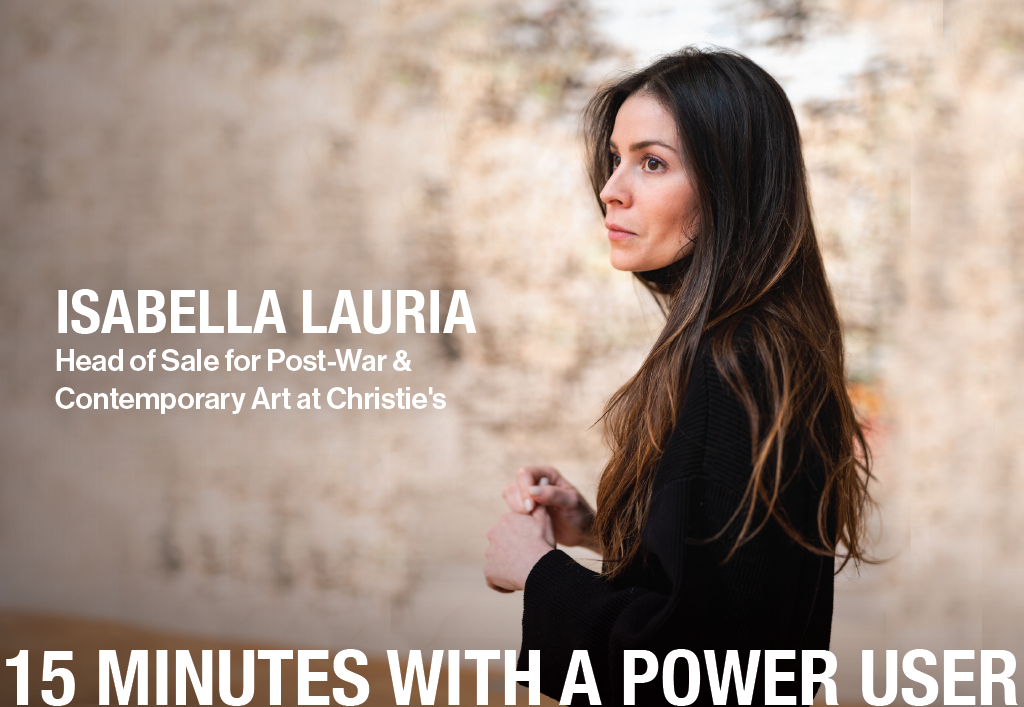Art World
15 Minutes With a Price Database Power User: Christie’s Postwar & Contemporary Art Specialist Isabella Lauria
In this series, we take 15 minutes to chat with some of the Artnet Price Database’s most dedicated users.

In this series, we take 15 minutes to chat with some of the Artnet Price Database’s most dedicated users.

Artnet Price Database Team

There is only one tool trusted by art-world insiders to buy, sell, and research art: the Artnet Price Database. Its users across industries—from auction houses to museums, galleries and government institutions—represent the art world’s most important players. We’re taking 15 minutes to chat with some of the Artnet Price Database’s power users to get their take on the current state of the market and how they’re keeping up with the latest trends.
When she was growing up, many of Isabella Lauria’s family vacations were focused on museum exhibitions of interest, but Isabella never imagined having a career in the art world herself. The Christie’s head of sale for Postwar & Contemporary art saw art as more of a passion or a hobby—until she spent a year working at a law firm.
“I quickly realized that I spent much more time in galleries than I did looking up legal precedent,” Isabella says. So she went back to school to get her master’s in art business with a focus in contemporary art. Today, her job at Christie’s involves introducing collectors to well-known as well as emerging and under-recognized artists. We had the chance to sit down with Isabella to chat about everything from shifts in the contemporary market to what she personally collects.
What keeps you working in the art world?
There are many professions in which every day is different, but I don’t think there are nearly as many that offer the opportunity to continue learning every single day. To remain relevant in this business you have to stay on top of all new artists and develop a real instinct for what people want now and what they will want in the future—which completely changes one day to the next. The thrill of constantly learning both from colleagues and clients as well as gauging where the market will go next is definitely what has me hooked.
How do you convince a collector to acquire work by an emerging artist they may not be familiar with?
Part of our role is to educate clients on new artists: why we see them as important and why we think they would make a good fit for their collection. I think doing the research and empowering clients with the ability to come to an informed decision is always the best approach in developing and building the client’s trust. The key is providing them with the tools and guidance to come to a decision rather than acting like a pushy salesman.
Many clients come in and immediately ask what the best investment would be, and I always tell them that it’s not the best way to think about buying art. There is never a guarantee that something will appreciate, but if it moves you and it makes you happy, you’ll never regret having bought it in the first place.
What do you collect?
I own a few works that I’ve bought over the years, all from artists working today, and always aim to buy at least one piece a year. Unrelated to art, I also collect Sonny Angel dolls and think by now, most people associate me with them. The fun part is you never know which one you’ll get! I’ve gifted them to friends, family and colleagues over the years. You can likely find one on most of the desks or offices of the Contemporary departments at both Sotheby’s and Christie’s.
Which artists do you think are currently undervalued, particularly mid-career artists?
I think the market has been re-examining many undervalued artists—African-American artists like Charles White and female artists like Alma Thomas to name a few. I also see a newfound interest in the Chicago Imagists. Roger Brown has been garnering great attention on the auction block over the past year, and I think that other Chicago Imagists will soon come into focus—Christina Ramberg is a great example. They are interesting to both established collectors as well as a younger audience. You can clearly see Ramberg’s influence on Julie Curtiss.

Julie Curtiss’s Pas de Trois (2018) shattered its $150,000 high estimate and sold for $423,000 at Christie’s New York in November 2019.
What is the biggest change you’ve seen in the contemporary market in the last five years? What’s your prediction for the market in the next five?
I think there’s been a strong shift to figuration over the past five years after a long period in which abstraction was the central focus of the market. We’ve also seen a big focus and skyrocketing prices for younger artists such as Amoako Boafo, Julie Curtiss, Eddie Martinez, and Nicolas Party over the past couple of seasons. This being said, I do believe that in the current climate we will see a continued focus on well-established blue-chip artists.
Do you have any advice for collectors looking to buy their first piece, or bid in their first auction?
My best advice would be to make sure that the first work that you purchase really speaks to you, and to forget about what the financial return might be. The most important thing is to really love what you collect.
Many clients come in and immediately ask what the best investment would be, and I always tell them that it’s not the best way to think about buying art. There is never a guarantee that something will appreciate, but if it moves you and it makes you happy, you’ll never regret having bought it in the first place. To me art is like music or religion, it speaks to everyone differently and as long as you let it, you’ll never feel like you made a mistake and the work will always be a memory of a particular time in your life. If you ask any top collector about the first work that they bought, they will always be thrilled to tell you the story. What you can know for sure, is that nine times out of ten, they also still own it and love it as much as they did when they bought it.
What was the last thing you searched for in the Price Database?
A Romare Bearden collage from 1969.
The Price Database is the art market research tool trusted by appraisers and aspiring collectors alike. To learn more and to choose from our range of subscription options, click here.